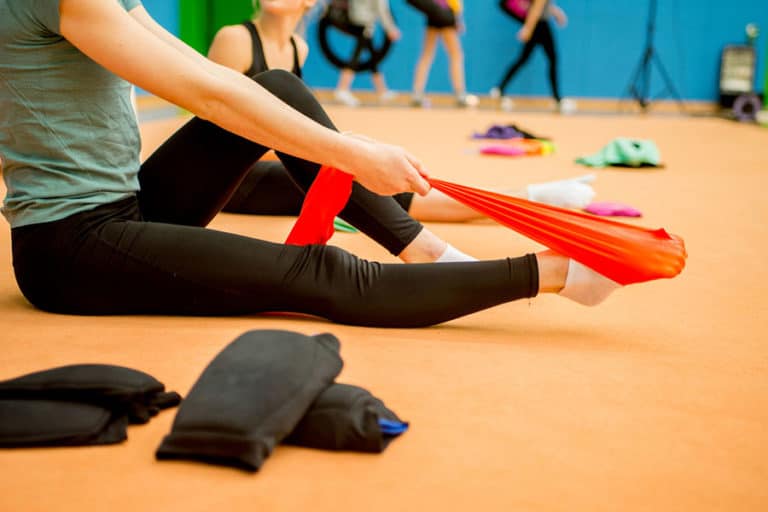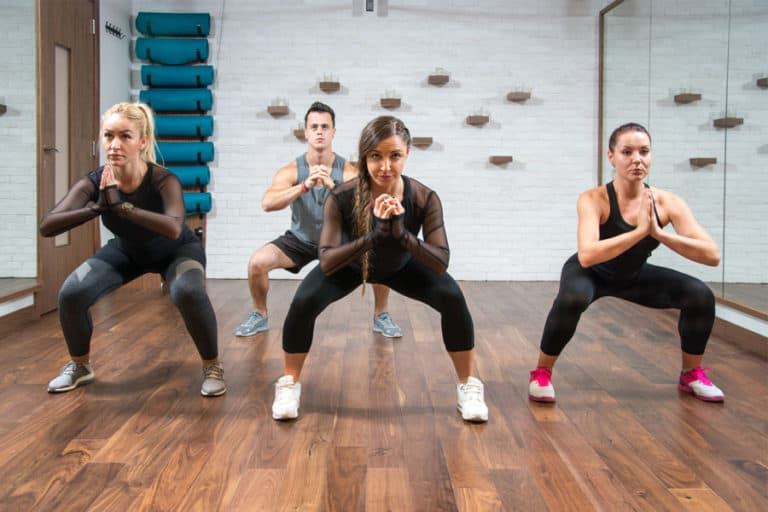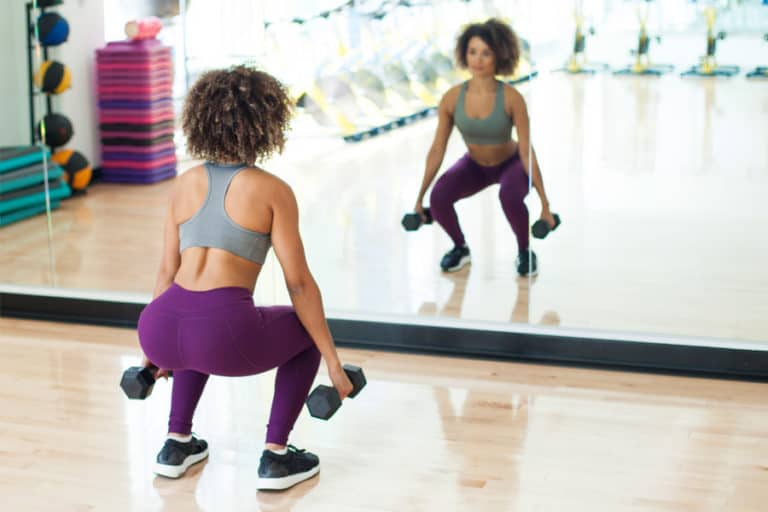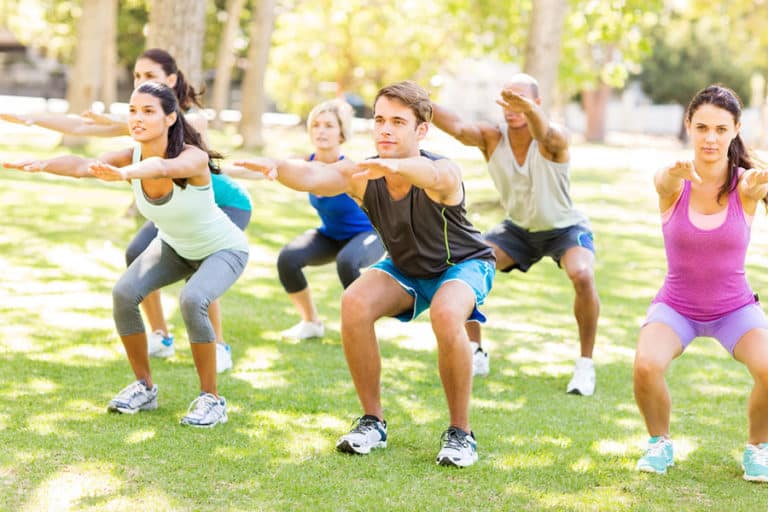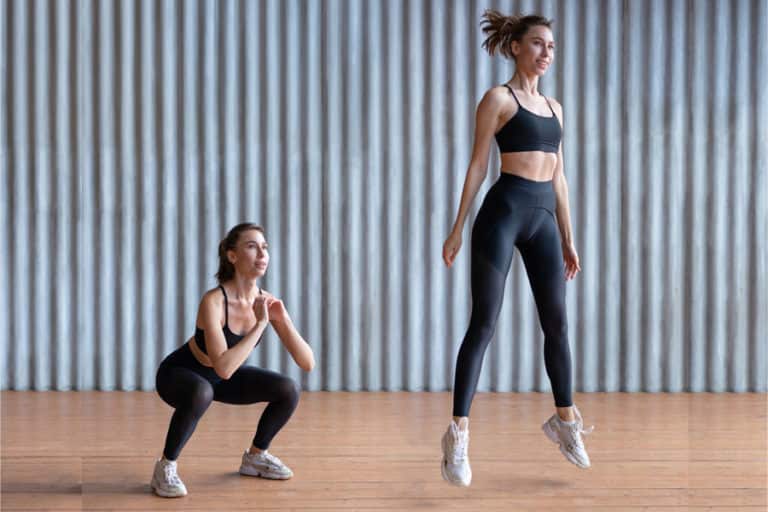Proper Squat Form – How To Do Squats Correctly?

How to do | Squat Variations | Safety tips | Common mistakes
The effects and the effectiveness of squats depend on how well you follow the squat form and its movement pattern. The precision of your form decides whether your squat workout ultimately gives you great lower body strength or a bad bout of joint pains or muscle soreness.
Learn the proper squat form
Understanding where and how each part of your body should be positioned during squats is crucial if you want to perfect your form. Here is a detailed guide to doing a squat perfectly.
Basic Bodyweight Squats
If you’re new to squats, the bodyweight squat is a great place to start. Here are factors you need to keep in mind if you want to perform a bodyweight squat with proper form [1]National Academy of Sports Medicine: SQUAT FORM – WHAT DOES IT TELL US? PART 1.
- Feet: [2]National Library of Medicine: How to squat? Effects of various stance widths, foot placement angles and level of experience on knee, hip and trunk motion and loading Keep your feet shoulder-width apart and firmly planted on the ground throughout the movement. Your weight should be shifted into your heels and not your toes. Do not let your heels rise or your toes turn inward at any time.
- Chest: It’s essential to keep your chest proud(high), so your spine remains in a neutral position. While you keep the chest high, do remember to keep your head high as well. No part of your upper body should be slouching, drooping, or facing down.
- Core: Your core should be engaged throughout the movement to prevent your lower back from rounding.
- Knees: Keep your knees in line with your toes throughout the movement. As you descend into a squat, your knees should track in the same direction as your toes.
- Hips: Send your hips back and down as if you are sitting on a chair. Try to keep your hips level and tucked in throughout this movement.
- Thighs: At the bottom of the move, your thighs should be parallel to the ground unless the squat type you are performing requires you to break past the parallel and descend lower.
- Squat movement and depth: Keeping in mind that your body stance is in keeping with the above directions, slowly lower your body by bending your knees and lowering your hips until your thighs are parallel to the ground. Pause for a moment and then return to the starting position.
Note: Squat form can sometimes vary depending on the type of squat you perform. Always seek the guidance of a physical trainer or a fitness expert before starting a squat routine.
Squats with weights
Once you perfect your squat form with bodyweight squats, you can start adding weights. You can do many weighted squat variations, but the basic steps and physical form will generally remain the same. Here are some variations you can try using different kinds of weights/weight equipment:
- Kettlebell squat
- Dumbbell squat
- Hack squat
- Barbell front squat
- Barbell back squat
Squats that help you perfect your form
Some squat variations involve movement patterns that can help you to practice the basic form and range of motion safely. Here is a list of such bodyweight and weighted squats:
Wall squat
The wall squat is similar to the basic squat in its form. The only thing that sets it apart is that this squat is performed with your back against a wall.
This move is excellent for beginners because the wall provides support and ensures that your back, chest, and legs maintain proper alignment and form every time you execute the squat movements.
How to do
- Stand with your back against the wall keeping your feet shoulder-width apart and 2 feet from the wall.
- Lower yourself down into a squatting position by bending your knees as your back slides down the wall.
- Ensure that your knees are bent at a 90-degree angle and that your thighs are parallel to the ground at the bottom of the movement.
- Hold this squat position for a few seconds, and then slowly stand back up.
Box squat
For anybody struggling to maintain proper form, the box squat can be an excellent practice exercise. When you perform box squats, you use a squat rack with a barbell and a box placed near the rack.
Since you will be seated on the box at the bottom of this squat movement, your thighs will consistently break parallel. Practicing with a box regularly will give you the confidence to squat deep enough each time.
How to do
- Place a box or bench of an appropriate height in front of the squat rack.
- Place your feet about hip-width apart and hold the barbell across your back.
- Keep your back straight and your core engaged.
- Bend your knees and lower your hips until your glutes touch the box.
- Push through your heels to stand back up.
- Repeat for the desired number of reps.
Deep squat
The deep squat requires your hips and thighs to go past the parallel(squat lower than you do in a basic squat). This squat is an excellent way to increase the mobility and flexibility required to perform squats.
How to do
- Place your feet shoulder-width apart and your toes pointing slightly outward.
- Bend your hips and knees to lower your body into a squat, making sure to keep your knees in line with your toes.
- Once your thighs are parallel to the ground, continue lowering yourself until your hips go past the parallel. Keep your flexibility levels in mind when you squat deep.
- To bail out of the squat, press through your heels to return to the starting position.
Goblet squat
The goblet squat [3]National Academy of Sports Medicine: HOW TO PERFORM GOBLET SQUATS FOR STRONGER GLUTES involves performing the basic squat with a weight(a kettlebell or dumbbell). The weight is held close to the chest and acts as a counterweight that keeps the body upright. This counterbalancing force helps to perfect your squat depth and form.
How to do
- Start by holding a dumbbell or kettlebell in front of your chest with both hands.
- Set your feet shoulder-width apart and keep your back upright.
- Lower your hips slowly, keeping your weight in your heels and your chest up and strong.
- Once your thighs are parallel to the ground, press through your heels to a standing position.
Smith machine squat
The smith machine squat is performed by holding a barbell that is attached to a machine(Smith machine). It is a great way to start performing squats with a barbell. The machine balances the weight of the barbell, making it safe to work with heavy, free weights.
How to do
- Adjust the Smith machine to your shoulder height.
- Stand with your feet shoulder-width apart and your knees bent.
- Place the bar across the shoulders and lower your hips until your thighs are parallel to the ground.
- From here, drive through your heels to return to the starting position.
Tips to progress with squats
If you wish to gradually progress from basic squats to advanced squats, use the following tips to improve your squat form and performance first. This way, you will reduce the risk of strain or injury in your squat workout journey.
- If you’re new to squatting, start with bodyweight squats. This will help you get used to the basic movement and to build proper form.
- Try different squat variations to keep your workouts interesting and challenge your muscles in different ways. You can try variations like the pistol squat, goblet squat, and jump squat.
- Add weights gradually. If you’re a beginner, start light and gradually increase your weight. When you add too much weight too quickly, it can lead to bad form and injury.
- Improving your lower body mobility will help you squat lower with proper form. Combine your squats with stretching and mobility exercises like hip hinges, lunges, and so on.
- Work on your balance by doing single-leg squats and other balance exercises. Squat movement should be fluid, and your body should move as one unit.
Common mistakes when doing squats
Now that you know how to squat correctly, it’s time to avoid common mistakes you may make while doing squats.
- If your hips do not lower until your thighs are parallel to the ground, you will not reap the full benefits of your squat workouts.
- Not engaging your core muscles while performing squats puts you at risk for lower back pain.
- Don’t let your chest droop or fall forward. This puts unnecessary stress on your lower back.
- Not keeping your knees in line with your toes is the most common culprit behind strained or aching knee joints after squat workouts.
- Very often, people notice their weight shifting to their toes and their heels lifting off the ground during a squat. This results in uneven distribution of body weight while performing the squat.
Conclusion
Now that you understand the squat form, you can start reaping the many benefits of this exercise. Remember to keep your form in mind to avoid common mistakes and injuries. The correct squat stance will help you build strength, improve your movement pattern, and build leg muscles.
References
| ↑1 | National Academy of Sports Medicine: SQUAT FORM – WHAT DOES IT TELL US? PART 1 |
|---|---|
| ↑2 | National Library of Medicine: How to squat? Effects of various stance widths, foot placement angles and level of experience on knee, hip and trunk motion and loading |
| ↑3 | National Academy of Sports Medicine: HOW TO PERFORM GOBLET SQUATS FOR STRONGER GLUTES |


